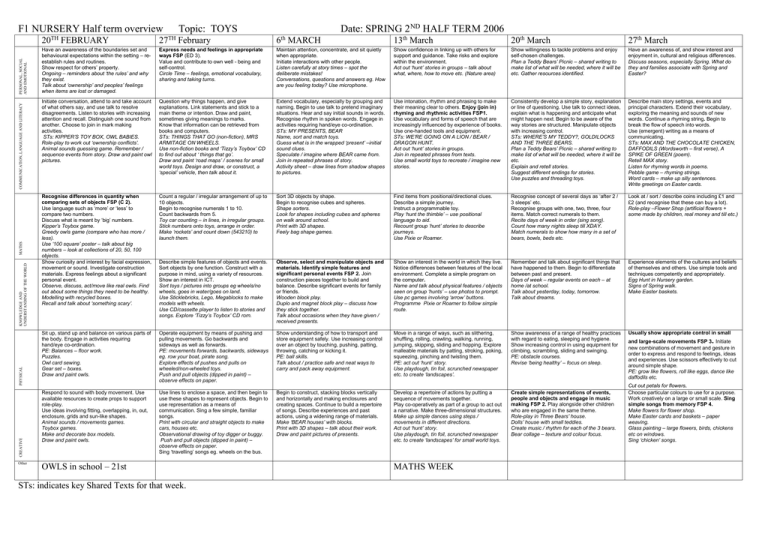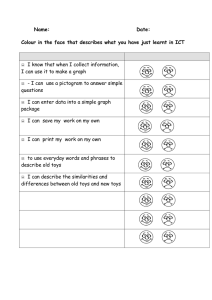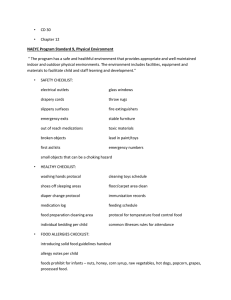ND
advertisement

CREATIVE PHYSICAL KNOWLEDGE AND UNDERSTANDING OF THE WORLD MATHS COMMUNICATION, LANGUAGE AND LITERACY PERSONAL, SOCIAL AND EMOTIONAL F1 NURSERY Half term overview Other Date: SPRING 2 ND HALF TERM 2006 Topic: TOYS 20TH FEBRUARY 27TH February 6th MARCH 13th March 20th March 27th March Have an awareness of the boundaries set and behavioural expectations within the setting – reestablish rules and routines. Show respect for others’ property. Ongoing – reminders about ‘the rules’ and why they exist. Talk about ‘ownership’ and peoples’ feelings when items are lost or damaged. Express needs and feelings in appropriate ways FSP (ED 3). Value and contribute to own well - being and self-control. Circle Time – feelings, emotional vocabulary, sharing and taking turns. Maintain attention, concentrate, and sit quietly when appropriate. Initiate interactions with other people. Listen carefully at story times – spot the deliberate mistakes! Conversations, questions and answers eg. How are you feeling today? Use microphone. Show confidence in linking up with others for support and guidance. Take risks and explore within the environment. Act out ‘hunt’ stories in groups – talk about what, where, how to move etc. (Nature area) Show willingness to tackle problems and enjoy self-chosen challenges. Plan a Teddy Bears’ Picnic – shared writing to make list of what will be needed, where it will be etc. Gather resources identified. Have an awareness of, and show interest and enjoyment in, cultural and religious differences. Discuss seasons, especially Spring. What do they and families associate with Spring and Easter? Initiate conversation, attend to and take account of what others say, and use talk to resolve disagreements. Listen to stories with increasing attention and recall. Distinguish one sound from another. Choose to join in mark making activities. STs: KIPPER’S TOY BOX, OWL BABIES. Role-play to work out ‘ownership conflicts’. Animal sounds guessing game. Remember / sequence events from story. Draw and paint owl pictures. Question why things happen, and give explanations. Link statements and stick to a main theme or intention. Draw and paint, sometimes giving meanings to marks. Know that information can be retrieved from books and computers. STs: THINGS THAT GO (non-fiction), MRS ARMITAGE ON WHEELS. Use non-fiction books and ‘Tizzy’s Toybox’ CD to find out about ‘ things that go’. Draw and paint ‘road maps’ / scenes for small world toys. Design and draw, or construct, a ‘special’ vehicle, then talk about it. Extend vocabulary, especially by grouping and naming. Begin to use talk to pretend imaginary situations. Hear and say initial sounds in words. Recognise rhythm in spoken words. Engage in activities requiring hand/eye co-ordination. STs: MY PRESENTS, BEAR Name, sort and match toys. Guess what is in the wrapped ‘present’ –initial sound clues. Speculate / imagine where BEAR came from. Join in repeated phrases of story. Activity sheet – draw lines from shadow shapes to pictures. Use intonation, rhythm and phrasing to make their meaning clear to others. Enjoy (join in) rhyming and rhythmic activities FSP1. Use vocabulary and forms of speech that are increasingly influenced by experience of books. Use one-handed tools and equipment. STs: WE’RE GOING ON A LION / BEAR / DRAGON HUNT. Act out ‘hunt’ stories in groups. Join in repeated phrases from texts. Use small world toys to recreate / imagine new stories. Consistently develop a simple story, explanation or line of questioning. Use talk to connect ideas, explain what is happening and anticipate what might happen next. Begin to be aware of the way stories are structured. Manipulate objects with increasing control. STs: WHERE’S MY TEDDY?, GOLDILOCKS AND THE THREE BEARS. Plan a Teddy Bears’ Picnic – shared writing to make list of what will be needed, where it will be etc. Explain and retell stories. Suggest different endings for stories. Use puzzles and threading toys. Describe main story settings, events and principal characters. Extend their vocabulary, exploring the meaning and sounds of new words. Continue a rhyming string. Begin to break the flow of speech into words. Use (emergent) writing as a means of communicating. STs: MAX AND THE CHOCOLATE CHICKEN, DAFFODILS (Wordsworth – first verse), A SPIKE OF GREEN (poem). Retell MAX story. Listen for rhyming words in poems. Pebble game – rhyming strings. Word cards – make up silly sentences. Write greetings on Easter cards. Recognise differences in quantity when comparing sets of objects FSP (C 2). Use language such as ‘more’ or ‘less’ to compare two numbers. Discuss what is meant by ‘big’ numbers. Kipper’s Toybox game. Greedy owls game (compare who has more / less). Use ‘100 square’ poster – talk about big numbers – look at collections of 20, 50, 100 objects. Show curiosity and interest by facial expression, movement or sound. Investigate construction materials. Express feelings about a significant personal event. Observe, discuss, act/move like real owls. Find out about some things they need to be healthy. Modelling with recycled boxes. Recall and talk about ‘something scary’. Count a regular / irregular arrangement of up to 10 objects. Begin to recognise numerals 1 to 10. Count backwards from 5. Toy car counting – in lines, in irregular groups. Stick numbers onto toys, arrange in order. Make ‘rockets’ and count down (543210) to launch them. Sort 3D objects by shape. Begin to recognise cubes and spheres. Shape sorters. Look for shapes including cubes and spheres on walk around school. Print with 3D shapes. Feely bag shape games. Find items from positional/directional clues. Describe a simple journey. Instruct a programmable toy. Play ‘hunt the thimble’ – use positional language to aid. Recount group ‘hunt’ stories to describe journeys. Use Pixie or Roamer. Recognise concept of several days as ‘after 2 / 3 sleeps’ etc. Recognise groups with one, two, three, four items. Match correct numerals to them. Recite days of week in order (sing song). Count how many nights sleep till XDAY. Match numerals to show how many in a set of bears, bowls, beds etc. Look at / sort / describe coins including £1 and £2 (and recognise that these can buy a lot). Role-play –Flower Shop (artificial flowers + some made by children, real money and till etc.) Describe simple features of objects and events. Sort objects by one function. Construct with a purpose in mind, using a variety of resources. Show an interest in ICT. Sort toys / pictures into groups eg wheels/no wheels, goes in water/goes on land. Use Sticklebricks, Lego, Megablocks to make models with wheels. Use CD/cassette player to listen to stories and songs. Explore ‘Tizzy’s Toybox’ CD rom. Observe, select and manipulate objects and materials. Identify simple features and significant personal events FSP 2. Join construction pieces together to build and balance. Describe significant events for family or friends. Wooden block play. Duplo and magnet block play – discuss how they stick together. Talk about occasions when they have given / received presents. Show an interest in the world in which they live. Notice differences between features of the local environment. Complete a simple program on the computer. Name and talk about physical features / objects seen on group ‘hunts’ – use photos to prompt. Use pc games involving ‘arrow’ buttons. Programme Pixie or Roamer to follow simple route. Remember and talk about significant things that have happened to them. Begin to differentiate between past and present. Days of week – regular events on each – at home /at school. Talk about yesterday, today, tomorrow. Talk about dreams. Experience elements of the cultures and beliefs of themselves and others. Use simple tools and techniques competently and appropriately. Egg Hunt in Nursery garden. Signs of Spring walk. Make Easter baskets. Sit up, stand up and balance on various parts of the body. Engage in activities requiring hand/eye co-ordination. PE: Balances – floor work. Puzzles. Owl card sewing. Gear set – boxes. Draw and paint owls. Operate equipment by means of pushing and pulling movements. Go backwards and sideways as well as forwards. PE: movements forwards, backwards, sideways eg. row your boat, pirate song. Explore effects of pushes and pulls on wheeled/non-wheeled toys. Push and pull objects (dipped in paint) – observe effects on paper. Show understanding of how to transport and store equipment safely. Use increasing control over an object by touching, pushing, patting, throwing, catching or kicking it. PE: ball skills. Talk about / practice safe and neat ways to carry and pack away equipment. Move in a range of ways, such as slithering, shuffling, rolling, crawling, walking, running, jumping, skipping, sliding and hopping. Explore malleable materials by patting, stroking, poking, squeezing, pinching and twisting them. PE: act out ‘hunt’ story. Use playdough, tin foil, scrunched newspaper etc. to create ‘landscapes’. Show awareness of a range of healthy practices with regard to eating, sleeping and hygiene. Show increasing control in using equipment for climbing, scrambling, sliding and swinging. PE: obstacle courses. Revise ‘being healthy’ – focus on sleep. Usually show appropriate control in small Respond to sound with body movement. Use available resources to create props to support role-play. Use ideas involving fitting, overlapping, in, out, enclosure, grids and sun-like shapes. Animal sounds / movements games. Toybox games. Make and decorate box models. Draw and paint owls. Use lines to enclose a space, and then begin to use these shapes to represent objects. Begin to use representation as a means of communication. Sing a few simple, familiar songs. Print with circular and straight objects to make cars, houses etc. Observational drawing of toy digger or buggy. Push and pull objects (dipped in paint) – observe effects on paper. Sing ‘travelling’ songs eg. wheels on the bus. Begin to construct, stacking blocks vertically and horizontally and making enclosures and creating spaces. Continue to build a repertoire of songs. Describe experiences and past actions, using a widening range of materials. Make ‘BEAR houses’ with blocks. Print with 3D shapes – talk about their work. Draw and paint pictures of presents. Develop a repertoire of actions by putting a sequence of movements together. Play co-operatively as part of a group to act out a narrative. Make three-dimensional structures. Make up simple dances using steps / movements in different directions. Act out ‘hunt’ story. Use playdough, tin foil, scrunched newspaper etc. to create ‘landscapes’ for small world toys. Create simple representations of events, people and objects and engage in music making FSP 2. Play alongside other children who are engaged in the same theme. Role-play in Three Bears’ house. Dolls’ house with small teddies. Create music / rhythm for each of the 3 bears. Bear collage – texture and colour focus. OWLS in school – 21st STs: indicates key Shared Texts for that week. MATHS WEEK and large-scale movements FSP 3. Initiate new combinations of movement and gesture in order to express and respond to feelings, ideas and experiences. Use scissors effectively to cut around simple shape. PE: grow like flowers, roll like eggs, dance like daffodils etc. Cut out petals for flowers. Choose particular colours to use for a purpose. Work creatively on a large or small scale. Sing simple songs from memory FSP 4. Make flowers for flower shop. Make Easter cards and baskets – paper weaving. Glass painting – large flowers, birds, chickens etc on windows. Sing ‘chicken’ songs.



